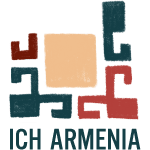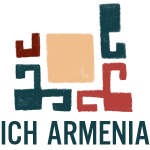Dialect
Dialects: The Armenian language is rich in dialects which are quite distinct. The distinctions can sometimes be so prominent, especially in the Eastern and Western groupings, that bearers of particular dialects often cannot understand each other.
Like any other language, Armenian has never been homogeneous, from the times it came to be. The land of the people who speak the language, the Armenian Plateau, due to its geophysical characteristics has naturally created economically and culturally isolated pockets for its inhabitants. As a result, the Armenian language gradually develops local variations – dialects, to which fact various borrowings from neighbouring languages have also contributed. Through constant contacts with each other, the Armenian dialects have been losing some of their old features and acquiring new ones. Which is to say, the Armenian language has not been immune to the historic process of emerging and disappearing of language variations.
We find the first evidence of dialectal occurrences in the works of the 5th century Armenian authors, written as mentioned above, in the Grapar (Old Armenian). But some references to specific dialects are to be found in a work of the 8th-century author Stepanos Syunetsi. There, he makes a distinction between the central and peripheral dialects. He does not specify the central dialects, probably on the premises of their being well-known, but he lists the peripheral ones: those of Korchyke, Tyke, Khoot, the Forth Hayk, Sperk, Syunik, Artsakh. Through a multi-facet retrospective analysis of modern Armenian dialects, academician Gevork Jahukian restores the local variations of the 5th century Armenian as south-western (Antioch), south-central, south-eastern, north-eastern dialects which in their turn had a number of sub-dialects.
There have been introduced a number of approaches to classify Armenian dialects. The best known is the first morphological classification done by academician Hrachia Acharian at the beginning of the 20th century, which is based on the formation of the present tense of the verbs. He differentiates “-OOM”, “-EL” and “-K” branches. The “-UM” branch [asoom em] comprises the majority of the Eastern dialects, including the literary Eastern Armenian of course. A number of variations of the Eastern grouping belong to the “-EL” branch, which later was to be called also “-LIS” [asel(is) im]. And the “-K” branch [kasem] takes in almost all dialects of the Western grouping, including the literary Western Armenian. Neither the morphological nor the phonetic approach to the classification, even applied simultaneously, can embrace the entire diversity of the Armenian language, as the results of later researches proved.
In mid-1970-es academician Gevorg Jahukian singled out 100 defining properties of the Armenian dialects, thus introducing a new multi-feature, the statistical method in Armenology which specified criteria to distinguish between dialect groupings, dialects and localisms. By this categorization, the Armenian dialectal units are first grouped in two branches -Western and Eastern, each of them in its turn comprising a number of dialectal groups. The Western dialectal groups are those of Antioch, Cilicia, Asia Minor, Hamshen, Ardeal, Moosh-Tigranakert and Van, and the Eastern ones are those of Khoy-Maragha, Ararat, Kharabagh-Shamakh, Agoulis-Meghri. These are further branched into separate dialects, the latter – into local lingos, then into sub-lingos. Thus, the Armenian dialects of the beginning of the 20th century can be grouped into two branches, 11 dialectal groupings, 44 dialects, 120 lingos, and numerous sub-lingos, which have not been counted. It is worth mentioning though, that the majority of dialectal units of the Western branch are introduced in their 1915 state of affairs since they had been written down from the survivors of the Armenian Genocide.
The use of the literary languages in formal schooling and modern publication facilities causes the gradual death of the Armenian dialects. It is a natural and irreversible process. The dialects of the Diaspora, cut away from their feeding environment, are disappearing even faster. Unfortunately, our dialects have not been collected and studied in their entirety. Whereas they safeguard relics that not only trace the origin and evolvement of the Armenian language but also could help resolve some thorny historical issues of the Armenian people. The rich and expressive resources of the Armenian dialects have enabled many an accomplished Armenian writer, such as Sayat-Nova (Tbilisi dialect), Khachatour Abovian (Yerevan dialect), Hakob Paronian (Constantinopolis), or Gabriel Soundoukian (Tbilisi) to create masterpieces of the Armenian literature.
Institute of the Language
Armenian National Academy of Sciences


